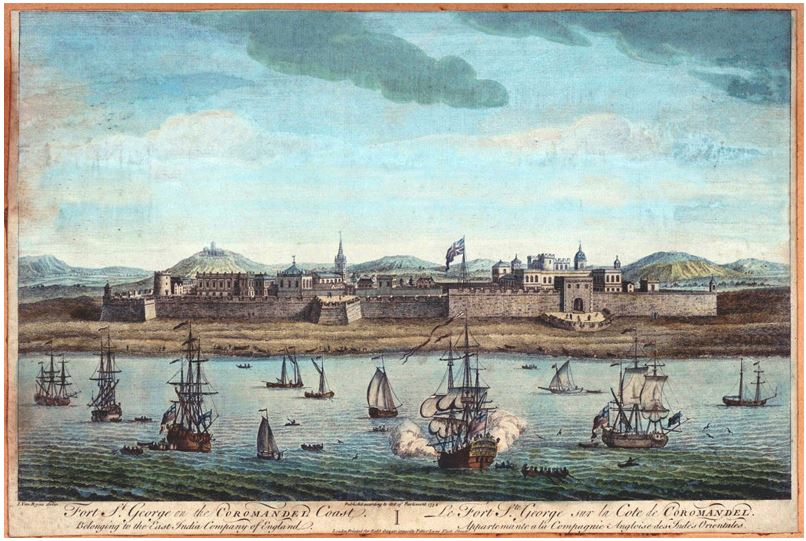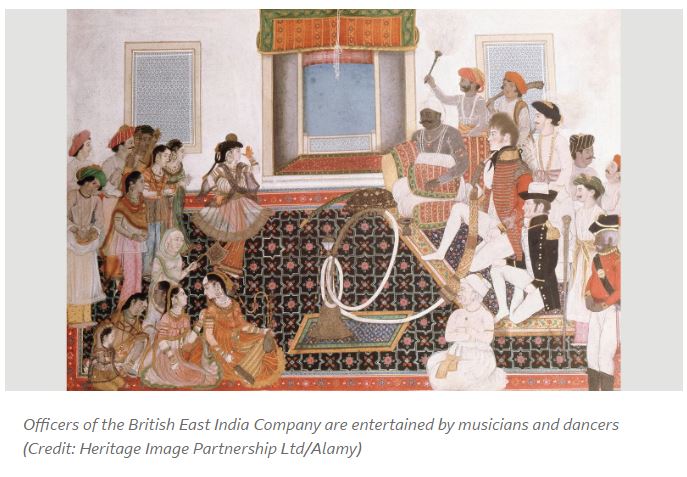The East India Company: Government and Administration c.1750-1857

Between 1757 and 1857, the East India Company was transformed from a purely mercantile venture into a major political power. The necessity to secure trading stations along the South Asian coastline – principally at Calcutta (modern Kolkata), Bombay (Mumbai) and Madras – led to increasing involvement in local politics through alliances with local rulers. At the same time, the global conflict with France, resulted in an increasingly expansive policy by the British on the subcontinent to counteract the influence of rival European powers. British presence in India was thus intrinsically tied into a wider network of global trade and politics. The letters of Sir Archibald Campbell, Governor of Madras, 1786-9, demonstrate this interaction between local politics and the wider world, dealing not only with the political, civil, and military affairs of Madras, but also with British relations with the French, the Dutch, and local Indian Princes.

The East India Company (EIC) had begun as an English trading corporation, guaranteed a monopoly of the East India Trade by Royal Charter in 1600. By clever financing (using techniques borrowed from the Dutch) it was able to ‘leverage’ its assets, expand its fleet, and soon outstrip rival European trading companies. With the failure of the Scottish Darien Company (which had attempted to pioneer a rival westward route to India via the Isthmus of Panama) and the Act of Union in 1707, Scottish merchants began to involve themselves in the Company’s activities. The taxes derived from its trade, became a vital resource of revenue to the British Government, and from 1773 (following the acquisition of Bengal) the Company was obliged to pay an annual tribute of £40,000 to Parliament. At the same time, the Company was appointed a Governor-General in India, based in Calcutta, to unite the administration. Prime minister William Pitt’s India Act of 1784 brought the East India Company more directly under the supervision of the British crown, with the creation of a Board of Control. After the appointment of Henry Dundas as the first President of the Board of Control (from 1793-1801) the number of Scots serving in the Company’s administration steadily increased, until by the end of the century one in five EIC officers was said to be of Scottish origin. Scots were also disproportionately to be found amongst both officers and soldiers within the ranks of the Company’s armies in India.
By the early nineteenth century, the East India Company had begun to derive its income increasingly from land revenue rather than trade, though the opium trade for instance remained important. However with the rising spirit of free trade in Parliament, the Company was deprived of its monopoly on East India commerce upon renewal of its charter in 1813, and in 1833 a further renewal of the charter obliged the Company to give up trade altogether and to become a species of export bank: financing private British traders, mainly through funds derived from the management of its newly acquired territories. From this point onwards the administration of Indian territory became a prime focus of the Company’s activities.
The guiding principle behind the early colonial state was based on the Orientalism of people like William Jones (1746-94), who argued that India was best ruled by its own laws and customs. Such policies required that British officials have a detailed understanding of the society that they were governing and the late eighteenth century was a productive period for orientalist scholarship on India, much of which was of both academic interest and administrative utility. The ideals of the Scottish enlightenment also played their part, especially during the 1820s and 1830s, when the Scottish (and Edinburgh educated) historian, economist, political theorist, and radical philosopher James Mill served in India House, rising to the position of head of the important department of Indian Correspondence. His controversial History of India, published in 1818, became a standard text for numerous future generations of British soldiers and civil servants.
Initially the British presented the Company Raj as the formal successor to Mughal rule and continued numerous indigenous practices in their style of governance. The legal system, for instance, was based strictly on Islamic law and the decisions of British judges had to be approved by Indian officials. The vast bureaucracy of the early colonial state employed thousands of Indian clerks, interpreters and minor officials, thus allowing a handful of British administrators to govern the ever increasing territories of the East India Company with its hundreds of thousands of Indian subjects.
British land policy in India had as its main objective the ‘modernisation’ and stream-lining of administration in order to increase the revenue. The new revenue-settlements introduced during the early decades of the nineteenth century had an immense and often very negative impact on the lives of Indian landowners and peasants. In some cases the enforced introduction of cash-crops such as indigo even led to famines. The intrusion of British rule in India was thus highly disruptive and often met with violent resistance. Indian rulers who opposed the colonial state were usually branded as rebels and suppressed with the use of military force. Feuds, banditry and violent crime were also seen as proof of the backward state of India and the inefficiency of Indian rulers who were often portrayed as corrupt and despotic (in order to reflect well upon East India Company rule).
The ethics of colonial rule in India did not go unchallenged in Britain. The actions and policies of the first Governor-General, Warren Hastings, lead to his impeachment in 1787 on charges including extortion, corruption, condoning torture and the waging of unjust wars and the passing of the India Act of 1784. By the early nineteenth century, in the wake of the Napoleonic Wars, the non-interventionist policy adhered to by the British in India was coming under pressure from the rising influence of Evangelicalism in the UK. It was no longer morally acceptable for the British to rule a continent of ‘heathens’ without actively seeking to civilize them. The suppression of widow-burning (sati, or the ritual suicide of Hindu widows), which had formerly been tolerated, became emblematic of the reformist zeal of British rule during the 1830s. The Indian elements of the Company administration were also minimized until the India Act of 1834, spearheaded by the politician Thomas Macaulay, finally did away with the last vestiges of Mughal practices. Missionaries were first officially allowed to proselytize in British India in 1813, although small contingents had been working surreptitiously on the subcontinent since the late eighteenth century. After 1813 their activities increased until they reached their most aggressive phase in the 1850s when Indian orphans, for instance, were commonly christened. On a more positive note, of course, British rule in India also meant the introduction of Western medicine and education (at least for a small fraction of the Indian elite), the establishment of an extensive railway network as well as the telegraph and other signifiers of the Industrial Revolution.
The expansionist policy of the British administration was continued throughout the first part of the nineteenth century. From isolated bases along the coast, British rule extended into the hinterland and eventually reached the border regions to the north-west and north-east. Through a series of military campaigns, the British defeated the remaining Indian powers which could challenge their rule, principally the Sikhs of the Punjab in 1845-9. There were set-backs, such as the ill-fated First Afghan War of 1839-42, and the north-west frontier remained troublesome for decades. By 1856, however, British (East India Company) rule over more than half of the sub-continent of India was firmly entrenched.

India, Raj & Empire – Adam Matthew Digital Library – documenting primary source materials of the history of South Asia between the foundation of the East India Company and the granting of independence to India and Pakistan.